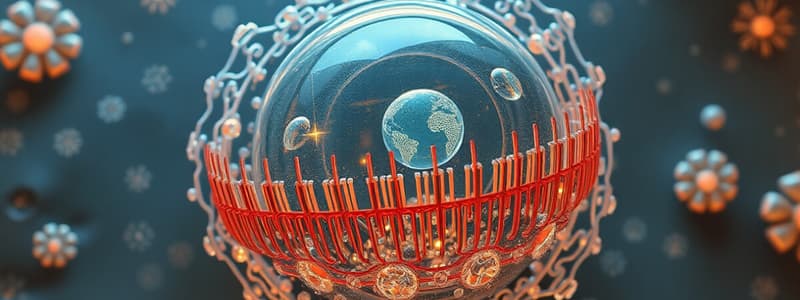Podcast
Questions and Answers
What role do integral proteins play in the cell membrane?
What role do integral proteins play in the cell membrane?
- They provide pathways for transport across the membrane. (correct)
- They form the lipid bilayer structure.
- They act as recognition sites for cell signaling.
- They stabilize the membrane during temperature fluctuations.
Which type of transport does require energy to move substances against their concentration gradient?
Which type of transport does require energy to move substances against their concentration gradient?
- Active transport (correct)
- Osmosis
- Facilitated diffusion
- Simple diffusion
What is the function of cholesterol in the fluid mosaic model of the cell membrane?
What is the function of cholesterol in the fluid mosaic model of the cell membrane?
- Provides structural support for peripheral proteins.
- Allows for the attachment of carbohydrate chains.
- Facilitates the movement of water across the membrane.
- Helps maintain membrane fluidity and stability. (correct)
What is the primary function of glycoproteins in the cell membrane?
What is the primary function of glycoproteins in the cell membrane?
What happens during phagocytosis?
What happens during phagocytosis?
How does temperature affect membrane permeability?
How does temperature affect membrane permeability?
Which factor primarily impacts the movement rate of molecules across membranes?
Which factor primarily impacts the movement rate of molecules across membranes?
Which molecules can diffuse freely across the cell membrane?
Which molecules can diffuse freely across the cell membrane?
What characteristic distinguishes prokaryotic cells from eukaryotic cells?
What characteristic distinguishes prokaryotic cells from eukaryotic cells?
Which organelle is primarily responsible for energy production in cells?
Which organelle is primarily responsible for energy production in cells?
In which cellular process does glycolysis occur?
In which cellular process does glycolysis occur?
Which of the following is NOT a function of the cell membrane?
Which of the following is NOT a function of the cell membrane?
What is the primary role of lysosomes in cellular processes?
What is the primary role of lysosomes in cellular processes?
What is a major consequence of a low surface area to volume ratio for larger cells?
What is a major consequence of a low surface area to volume ratio for larger cells?
What is the product of anaerobic respiration in yeast?
What is the product of anaerobic respiration in yeast?
What type of cells are stem cells classified as, due to their division capabilities?
What type of cells are stem cells classified as, due to their division capabilities?
What happens to the surface area to volume ratio as cells increase in size?
What happens to the surface area to volume ratio as cells increase in size?
Which of the following is a characteristic feature of prokaryotic cells?
Which of the following is a characteristic feature of prokaryotic cells?
Which organelle is responsible for conducting photosynthesis in plant cells?
Which organelle is responsible for conducting photosynthesis in plant cells?
How do organisms acquire the energy needed for cellular processes?
How do organisms acquire the energy needed for cellular processes?
What function does the endoplasmic reticulum (ER) serve in eukaryotic cells?
What function does the endoplasmic reticulum (ER) serve in eukaryotic cells?
Why is a higher surface area to volume ratio beneficial for cells?
Why is a higher surface area to volume ratio beneficial for cells?
Which structure in eukaryotic cells is primarily involved in ATP production through cellular respiration?
Which structure in eukaryotic cells is primarily involved in ATP production through cellular respiration?
What role do plasmids play in prokaryotic cells?
What role do plasmids play in prokaryotic cells?
Flashcards are hidden until you start studying
Study Notes
Cell Membrane Structure
- The cell membrane is a dynamic structure with various proteins embedded in a fluid lipid bilayer
- The phospholipid bilayer is fundamental to the membrane, with hydrophilic heads facing outward and hydrophobic tails facing inward, creating a barrier.
- Integral proteins span the membrane, allowing for transport while peripheral proteins attach to the surface, aiding in signaling and structural support
- Cholesterol embedded within the phospholipid bilayer helps to maintain membrane fluidity and stability across varying temperatures
- Glycoproteins on the membrane surface are carbohydrate chains attached to proteins and act as recognition sites for cell signaling and immune responses.
Passive Transport
- Diffusion is the movement of molecules from an area of higher concentration to an area of lower concentration. Small nonpolar molecules like oxygen and carbon dioxide can diffuse freely across the membrane.
- Osmosis is a specialized type of diffusion where water moves across a selectively permeable membrane.
- Osmosis is driven by water potential differences (concentration gradients).
- Osmosis occurs through special channels called aquaporins.
Active Transport
- Active transport requires energy (ATP) to move substances against their concentration gradient.
- The sodium-potassium pump is an example of Active Transport, moving sodium ions out of the cell and potassium ions into the cell which is essential for maintaining cellular potential and volume.
Endocytosis
- Endocytosis is the process of engulfing large molecules or particles by enclosing them in a membrane vesicle.
- Phagocytosis is a type of endocytosis where the cell engulfs solid particles, such as immune cells engulfing pathogens.
Factors Influencing Movement Across Membranes
- Factors that influence movement include the concentration gradient, the size and polarity of molecules, and membrane permeability.
- Steeper concentration gradients increase movement rates.
- Small, nonpolar molecules diffuse more easily, and membrane permeability is influenced by temperature and membrane composition.
Surface Area to Volume Ratio
- As cells increase in size, volume grows faster than surface area, resulting in a reduced surface area to volume ratio.
- A higher surface area to volume ratio facilitates more efficient diffusion of materials.
- Cells adapt by staying small or developing specialized structures like microvilli to maintain a favorable surface area to volume ratio.
Cell Requirements for Survival
- Organisms require energy to fuel cellular processes.
- Energy can be obtained from sunlight through photosynthesis or chemical compounds through respiration.
- Cells require matter such as essential gases, nutrients, and minerals for their cellular functions.
- Cells produce metabolic waste that must be efficiently removed to maintain homeostasis.
Common Features of Prokaryotic and Eukaryotic Cells
- Both prokaryotes and eukaryotes possess DNA, ribosomes for protein synthesis, and a plasma membrane, reflecting their common evolutionary ancestry.
Prokaryotic Cells
- Prokaryotic cells are characterized by a simpler structure.
- They lack a true nucleus, instead, their DNA is located in the nucleoid region.
- They typically possess a single circular chromosome and are generally smaller (1-10 µm)
- Prokaryotes often possess plasmids (small DNA circles) and may have structures like flagella for movement.
Eukaryotic Cells
- Eukaryotic cells are more complex and larger (10-100 µm).
- They contain membrane-bound organelles that compartmentalize cellular functions.
- Specialized organelles include chloroplasts (sites of photosynthesis in plant cells), mitochondria (powerhouses of the cell for ATP production through cellular respiration), the endoplasmic reticulum (rough ER synthesizes proteins, smooth ER synthesizes lipids), and lysosomes (contain digestive enzymes to break down waste materials).
Identification of Structures
- Chloroplasts are green due to chlorophyll and are essential for photosynthesis.
- Mitochondria are double-membrane organelles and involve in energy production.
- Rough ER is studded with ribosomes and essential for protein synthesis.
- Lysosomes are membrane-bound vesicles involved in waste processing.
Comparing Cell Types
- Prokaryotes lack membrane-bound organelles and have a single chromosome.
- Eukaryotes have multiple chromosomes and contain organelles.
ATP Production
- Organisms use cellular respiration to convert energy stored in glucose into ATP through a series of enzyme-mediated reactions that release energy.
Photosynthesis Overview
- Photosynthesis follows the chemical equation: 6CO₂ + 6H₂O + light energy → C₆H₁₂O₆ + 6O₂.
- Photosynthesis occurs in two main stages: the light-dependent reactions and the light-independent reactions (Calvin Cycle).
- Light-dependent reactions occur in the thylakoid membranes, converting solar energy into chemical energy (ATP and NADPH) using water, and releasing oxygen as a byproduct.
- Light-independent reactions (Calvin Cycle) occur in the stroma, using ATP and NADPH to convert CO₂ into glucose.
Cellular Respiration
- Cellular respiration is a series of metabolic processes that convert glucose into ATP and occurs in three main stages: glycolysis, the Krebs cycle, and the electron transport chain.
- Glycolysis takes place in the cytoplasm and breaks down glucose into pyruvate, producing a small amount of ATP and NADH.
- The Krebs cycle occurs in mitochondria and further breaks down pyruvate into CO₂, generating ATP, NADH, and FADH₂.
- The Electron Transport Chain utilizes NADH and FADH₂ to generate ATP, through oxidative phosphorylation.
Anaerobic Respiration
- Anaerobic respiration occurs in the absence of oxygen and is less efficient than aerobic respiration.
- Anaerobic respiration produces lactic acid (in animals) or ethanol and CO₂ (in yeast) via fermentation pathways.
Stem Cells
- Stem cells are unspecialized cells capable of dividing indefinitely and differentiating into various cell types, which is critical for development and repair.
Studying That Suits You
Use AI to generate personalized quizzes and flashcards to suit your learning preferences.




